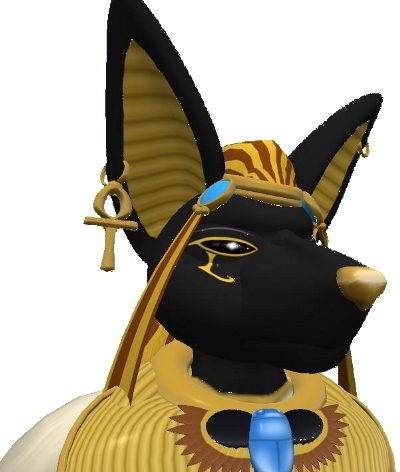The stereotype of the Furry, whether inside Second Life or out, has been abused out of all proportion. Let us establish a new stereotype of Furries. They have a tendency towards shyness and reticence, understandable given the substantial drubbings they have received, but perhaps also part of their natures. When they create representations of themselves, they tend to use anthropomorphic personifications.
So far, so good. Remember I’m talking about a stereotype here – I’m not intending to describe any one individual. To continue, the stereotypical Furry is not obsessive when it comes to sex. Or, perhaps, anything else. They have more of a tendency to be tolerant and accepting. That’s what you’re into, they ask? Great, hope you enjoy it, and play safe – don’t hurt anyone doing it. Specific Furry individuals have commonly had other traits: curiosity, generosity, respect, common sense.
So much for breaking the commonly-held stereotypes surrounding Furries. What do Furries have in common? What attracts them to being Furry, whether they be Furry fans or follow a Furry lifestyle?
Humanity – is it a base condition?
Every Fur, from one end of the spectrum to the other, exists inside a human body, and necessarily has some traits associated with that form. Whether the Furriness manifests as a desire to dress differently and to stand out from other people, or as a knowledge that the person has an other-than-human soul, every Fur has some human traits, and as such, like all humans, has a tendency to act in predictably human ways.
As with any grouping of human beings, some of the individuals in this group are nasty, petty, obsessive, and can possess a whole host of other negative traits. This is the aspect of Furriness that is often portrayed by the media, and that’s unfortunate, because it all boils down to stereotypes generated based on input from a minority of cases.
On the flip side, humans like to identify themselves with traits that they see as being positive. Who can say that they did not play dress-ups as a kid – Pretty Princesses, Cowboys and Indians, Jedi Knights – and pretend to be heroes or distressing damsels or even villains, with all the connotations that underlie those ideas?
Positively Furry
Animals – whether for reasonable or unreasonable reasons – are often associated with human traits – the lion is noble, the hyena cowardly, the dog loyal. Sometimes these traits are actually possessed by said animal, but in just as many cases traits are allocated based on looks, or, other misguided reasonings. Whatever the purpose of allocating these traits might have been, we have been handed down a rich variety of animals and associated traits to work with. As we said earlier, being Furry is not a single fixed idea, there is a spectrum. At one end of the spectrum, we have folks who put on and take off their Furry apparel and personas as easily as changing clothing. Indeed, they see Furriness as a temporary condition, perhaps putting it on to indicate how they are feeling, or to change how they are feeling. They identify or resonate with the traits portrayed by the animal or parts thereof that they don, but are not attached in identity to one form. At the other extreme, we find those people who fully identify with a single representation, and the traits that go with that representation. Somewhere in the middle, are those who resonate with a representation, but do not feel that they are in an incorrect body.
A very brief history
The use of the term “Furry” dates back to perhaps the early 1980s. Tthe practice of dressing up as an animal, or adding parts of animals such as ears or tails or masks to a costume in order to symbolise taking on the characteristics of that animal, dates back so far that the origins are lost in time. Even today, in the remnants of the ancient religions, we see shamans and other tribesfolk taking on animal roles and appearances, to tell stories, and to add to the flavour of those stories. The ancient Egyptians gave their depictions of their Gods’ animal parts, linking the appearance of those Gods to the traits those animals where believed to have. More recently, mummers would often dress-up as a part of their plays, donning animal masks and other parts at times, to elucidate their tales. More recently yet, the cartoons and shows popular with children are filled with a veritable menagerie of characters – in essence, animals have taken the place of heroes and villains from the stories of older civilisations, and children are often being encouraged to identify with animal characters instead of people from those older stories.
In conclusion
When we are young and naive, the world is a big place, full of external forces that tower over us. First there are our parents or guardians who, like gods, know everything. Then there are the more advanced role models: bosses, rock stars, actors, and others who manage to masquerade as our power archetypes. They represent to us our own undeveloped sexual, artistic, or professional powers, aspects of individuality we do not yet possess. For a while we give them authority over us; we give them our energy by buying their albums, supporting their causes, and recruiting others into their reservoir of power. On subtle levels our ritual acts of patronage even project part of our aura in their direction. (God Forms of High Magic)
And so, animals have become role models to some of us.
We’ve all dressed up, or changed our hair cuts, or bought new cars to make us seem more confident, or cooler, or more appealing. When we want access to a particular trait, either externally or internally, we put on the trappings associated with that trait.
Being Furry is an uncommon choice, but for most Furries, the genesis is commonplace.

Very well written, Thanks!
Wolfie!
Very well written, Thanks!
Wolfie!